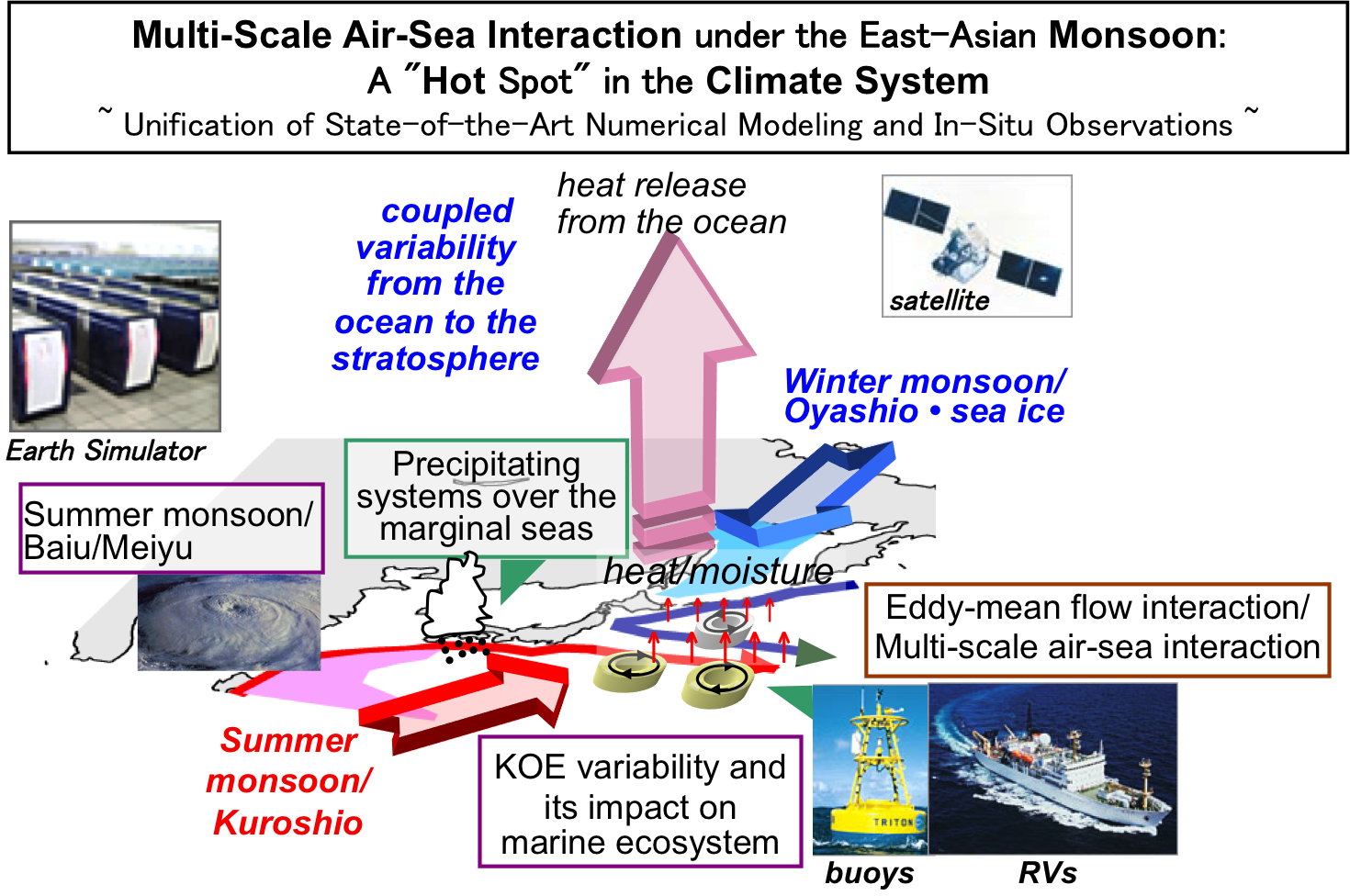Steering Team
Promotion and supervision of project research activity on extratropical atmosphere-ocean coupled system
PI: Prof. Hisashi Nakamura, Research Center for Advanced Science and Technology, University of Tokyo
Under the "two-way (meridional and zonal land-sea) thermal contiguousness" owing to the heat transport by the Kuroshio and Oyashio Currents and by the East-Asian Monsoon, there is a great variety of vigorous interactive phenomena in the atmosphere and ocean (including sea ice) that are involved in the release of a huge amount of heat and moisture from the ocean into the atmosphere. Deepening of our understanding of the underlying mechanisms of those phenomena is the primary goal of this project. Within the midlatitude oceanic frontal zone east of Japan, where a warm western boundary current is confluent with a cool current, or in the marginal seas (East China Sea, Sea of Japan, and Sea of Okhotsk), meso-scale ocean eddies are active, in interacting with convective/stratiform cloud systems aloft and large-scale oceanic current systems, to form a multi-scale interactive system as the most distinct "hot-spot” in the global climate system. By effectively combining state-of-the-art numerical modeling, analysis of the latest satellite data and well-designed unique in-situ observations, we aim to reveal the role of those interactions not only in regional weather and oceanic conditions as well as in the marine ecosystem in the vicinity of Japan, but also in the variability of the global atmospheric circulation, and climate systems as well as in the surface environment, in attempting to understand the underlying mechanisms. In order to accomplish our research goals, the steering team supervises each of the main/supplementary programs and the two supporting teams as well as the young researchers' association (Young Hot Spotters: YHS) organized under this steering team.

Supporting teams
Supporting team for numerical modeling study
This team under the steering team is led by A. Kuwano-Yoshida (A03-7 member; also a member of the steering team) and supported by B. Taguchi, H. Sasaki (A02-5 members), N. Komori (A03-7 member), T. Enomoto (A02-6/A03-8 adjunct member), and Wataru Ohfuchi (A03-7 adjunct member). All the members, who belong to the Earth Simulator (ES) Center of JAMSTEC, are quite experiemced in high-resolution numerical models on ES. They provide an enormous amount of output of data with extremely high resolution in space extended in time, which cannot be obtained only from in-situ observations. We have already confirmed that these high-resolution models can realistically reproduce the atmospheric/oceanic circulations and the formulation of cloud/ precipitation systems. The major role of this supporting team is managing enormous amount of the model output data to provide them to researchers who join this project. Supported by ESC engineers, the team also plays an important role in assisting the researchers who conduct high-resolution model experiments on ES to advise them on parallel computing and graphics.
The Earth Simulator Center, Geophysical Fluid Simulation Research Group
Supporting team for in-situ observations/buoy monitoring
This team under the steering team is composed of all members of the observation program (A02-6) and all PIs of main/supplementary programs. Y. Kawai (PI of A02-6) acts as the leader of this team. To effectively carry out in-situ observations planned by individual main/supplementary programs, the team coordinates inter-program collaborations within this project and, if necessary, those with related research projects. Most of the members of the observation program are full-/part-time researchers in JAMSTEC or Fisheries Research Agency (FRA), who can be involved effectively in reserving ship time of R/Vs operated by those institutes and preparing observational equipments. Involvement of PIs of other programs is necessary for ship-time reservation of R/Vs of universities and other institutes and to effective utilization of observational equipments. Under the leadership of this team, we support the observational campaigns planned in FY 2012 and 2013 by the entire project. The team also encourages collaborations among in-situ observations carried out by individual programs and between our project and others, for effective use of ship time and observational equipments.
Young researchers' association: "Young Hot Spotters" (YHS)
The ultimate goal of the young researchers' association or "Young Hot Spotters" (YHS) is to propose plans for further promoting research activity within our project. Research associates, PDs, graduate students and even undergraduates join this association. Toward the ultimate goal, active discussions and exchange information are made frequently among the members on Internet and sometimes in YHS meetings.

